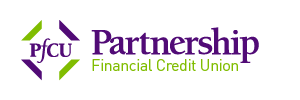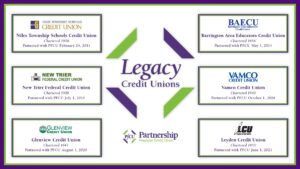OUR HISTORY
Partnership Financial Credit Union (PFCU) is a member-owned, not-for-profit financial institution with origins dating back to 1941. PFCU was founded in 2014, when four credit unions — Niles Township Schools, New Trier Federal, VAMCO and Barrington Area Educators — partnered in the best interest of their members. Two additional credit unions joined our partnership, Glenview Credit Union in 2020 and Leyden Credit Union in 2021.
Today, PFCU is a full-service credit union serving more than 15,000 members. We remain dedicated to maintaining close personable relationships with our members while delivering the best possible products and services. We strive to offer the most competitive rates while maintaining our own financial security and stability, which in turn, allows us to provide the same assurance to our members.
OUR MISSION
The mission of PFCU is to be the best financial institution in the eyes of our members, our employees and the communities we serve.
MEMBERSHIP
Want to join the PFCU family and experience the credit union difference? To qualify for membership, you must meet one of the following:
- Be employed by one of PFCU’s Select Employee Groups
- Live or work within the area bounded by:
- Illinois/Wisconsin border on the north
- North Avenue (Route 64) on the south
- Lake Michigan on the east
- Route 47 on the west
- And the townships of Lyons, Proviso, York, and Leyden.
- Be an immediate family member of an existing member, regardless of where you live or work.
Membership lasts a lifetime! Once a member, always a member.
Please note that to help the government fight the funding of terrorism and money laundering activities, federal law requires all financial institutions to obtain, verify and record information that identifies each person who opens an account or is added to an existing account. What this means for you: When you open an account, we will ask for your name, address, date of birth and other information that will allow us to identify you. We may also ask to see your driver’s license or other identifying documents.
All PFCU deposits are insured up to $250,000 by the National Credit Union Administration, a U.S. government agency.
OUR VALUES
- Member Focus
- Outstanding Personal Service
- Integrity
- Stability
- Financial Responsibility
- Member Financial Development
THE CREDIT UNION DIFFERENCE
Credit unions are cooperative, not-for-profit financial institutions organized to promote thrift and provide credit to members. They are member-owned and controlled through a board of directors elected by the membership. The board serves on a volunteer basis and may hire a management team to run the credit union. The board also establishes and revises policy, sets dividend and loan rates, and directs certain operations. The result: Members are provided with a safe, convenient place to save and borrow at reasonable rates at an institution that exists to benefit them, not to make a profit.
Credit unions exist to serve specific groups of people, such as a group of employees or the members of a professional or religious group. This is called a “field of membership.” The field of membership may include where they live, where they work, or their membership in a social or economic group.
Member Owned
Most financial institutions are owned by stockholders, who own a part of the institution and intend on making money from their investment. A credit union doesn’t operate in this manner. Rather, each credit union member owns one “share” of the organization. The user of credit union services is also an owner and is even entitled to vote on important issues, such as the election of member representatives to serve on the board of directors.
The CU Movement
The first credit union cooperatives started in Germany over a century ago. Today, credit unions are found everywhere in the world. The credit union movement started in this country in Manchester, New Hampshire. There, the St. Mary’s Cooperative Credit Association, a church-affiliated credit union, opened its doors in 1909. Today, one in every three Americans is a credit union member.
The primary purpose of a credit union is to encourage members to save money. Another purpose is to offer loans to members. In fact, credit unions have traditionally made loans to people of ordinary means. Credit unions can charge lower rates for loans (as well as pay higher dividends on savings) because they are nonprofit cooperatives. Rather than paying profits to stockholders, credit unions return earnings to members in the form of dividends or improved services.




